This eggless cornbread is light, fluffy, and everything cornbread should be!
While this is an egg free cornbread, you'd never know it because it is just as delicious as regular cornbread.
This eggless cornbread recipe is based off of my very popular cornbread without milk recipe, and since this cornbread is made without eggs and happens to use water instead of milk, it is actually vegan friendly.
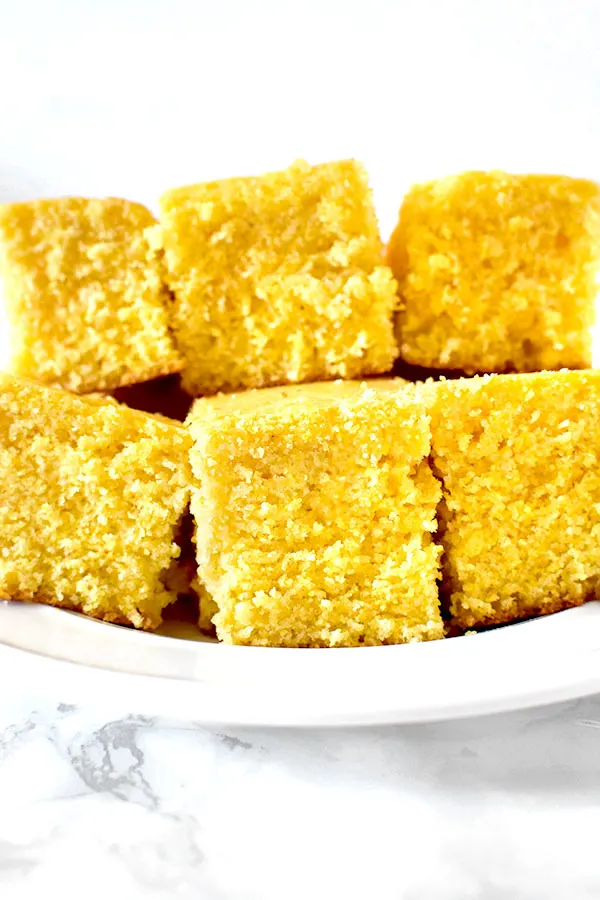
One thing I find particularly annoying about cooking to address specific diets is how few good recipes there are out there.
In fact, in my experience, there aren't that many recipes in general that address food allergies (even if there are plenty of recipes for the latest fad diet).
My dairy free cornbread is a fan favorite, because as a foodie, I simply refuse to eat food that is sub par in flavor.
Then, I got comments asking me about making eggless cornbread.
I had never thought about making cornbread without eggs before...
In fact, I wasn't even sure you could make egg free cornbread or anything egg free.
Then, I started doing some research and discovered not only could I, but I could do it without sacrificing any flavor!
So, I did 🙂
History of Cornbread
Native people of the Americas had a kind of cornbread which was later adopted by European settlers - especially those who lived in Southern colonies.
In those times, cornbread was a simple combination of ground cornmeal and water that was baked over an open fire or in a hearth.
While eaten in both the North and the South, cornbread importance in Southern cuisine began out of necessity, because due to the climate European wheat wither and turn rancid.
Then, in the 1800s, eggs, buttermilk, baking soda, baking powder, and fat were added and turned cornbread into a version similar to cornbread as we know it today.
However, it wan't until the 1900s when flour and sugar were added.
This was due to traditional stone mills being replaced with steel roller mills.
The heat from the steel rollers reduced both the corn kernel's flavor size of the cornmeal. As a result, sugar and flour were added to compensate for the reduced sweetness and texture.
Can you make cornbread without eggs?
While most cornbreads are made with eggs, that is not strictly necessary.
However, since help bind the ingredients together, act as a mild leavening agent, and they add moisture, you need to replace them.
Egg substitute for cornbread
You can actually make cornbread without eggs by replacing the eggs with ¼ cup of water per egg.
You can also substitute it with apple sauce or some of the other egg alternatives used for baking, but I like this way best because it doesn't alter the flavor or texture.
HOW TO REPLACE EGGS IN BAKING
Eggs do three things in most recipes: they help bind the ingredients together, act as a mild leavening agent, and they add moisture.
So, to replace them, the ideal options do all three and do not impact flavor or texture.
While there are other ways to replace eggs in baking, these are the ones that I think are the best:
Applesauce
Unsweetened applesauce is my favorite way to replace eggs in baking.
It barely, if at all, affects the flavor and is easy to find in grocery stores.
Using ¼ cup (about 65 grams) of applesauce can replace an egg in most recipes.
Vinegar and baking soda
Mixing 1 teaspoon (7 grams) of baking soda with 1 tablespoon (15 grams) of vinegar can replace 1 egg in most recipes.
According to Healthline, when mixed together, vinegar and baking soda start a chemical reaction that produces carbon dioxide and water, which makes baked goods light and airy.
This substitute works best for cakes, cupcakes, and quick breads.
Arrowroot powder or cornstarch
A mixture of 2 tablespoons of arrowroot powder or cornstarch and 3 tablespoons of water can be used to replace 1 egg.
Aquafaba
"Aquafaba" is the term for the leftover liquid from cooking beans or legumes and is the same liquid that’s found in canned chickpeas or beans.
The liquid has a very similar consistency to that of raw egg whites, making it a great substitute for many recipes.
You can use 3 tablespoons (45 grams) of aquafaba to replace 1 egg.
Carbonated water
Carbonated water can add moisture to a recipe and acts as a great leavening agent.
The carbonation traps air bubbles, which help make the finished product light and fluffy. This works great for cakes, cupcakes, and quick breads.
You can replace each egg with ¼ cup (60 grams) of carbonated water.
QUICK BREADS VS YEAST BREADS
Yeast breads are breads made using yeast, such as white bread and dinner rolls. Basically, it's what you think of when you hear the word "bread".
Quick breads, which originated in the United States, are breads that are leavened with baking soda or baking powder instead of yeast. This allows them to be prepared quickly in comparison to the time it takes to make breads made with yeast.
Irish soda bread and biscuits are two examples of quick breads.
However, banana bread, cornbread, and pumpkin bread are also quick breads, even though they seem more like somewhat dense cakes.
Even more surprisingly, muffins, like blueberry muffins and banana muffins, are also a type of quick bread.
THE DIFFERENCE BETWEEN QUICK BREAD AND CAKE
Quick breads are denser than cake and usually require less sugar.
FLOUR Used For Quick Bread
Even though "bread" is in the name, quick breads should not be made with bread flour.
Bread flour has a higher protein content than all-purpose, which helps with gluten development. This creates a chewy texture and a heavier, denser bread.
These are not qualities you want from your quick bread.
You could use cake flour, but generally, all-purpose flour is used.
BREAD FLOUR VS ALL-PURPOSE FLOUR
Bread flour has a higher protein content than all-purpose, which helps with gluten development.
This creates a chewy texture and heavier and denser bread. This can be great in recipes like bread bowls. However, it is less desirable in breads like challah bread, which you want to be light and fluffy.
All-purpose flour has a lower protein content, but can generally be substituted for bread flour.
Can I use whole wheat flour instead?
Generally, if you want to use whole wheat flour in bread, it's recommended to replace up to half of the all-purpose flour called for with whole wheat flour.
HOW TO MEASURE FLOUR AND OTHER DRY INGREDIENTS
The best way to measure dry ingredients is with a scale. However, this is not commonly done in the United States, where dry measuring cups are used instead.
To measure most dry ingredients, first spoon them into a dry measuring cup and then level off the measuring cup with an upside-down butter knife.
Make sure not to pack it down because it can lead to using more of the ingredient than called for.
The exception is brown sugar. To measure brown sugar, pack it into the measuring cup and then level off any excess.
To measure chocolate chips, nuts, or dried fruit, just pour them in and then level them off.
DRY VS LIQUID MEASURING CUP
Dry measuring cups are a set of cups that often come with measuring spoons. Each cup is a different measurement just like each spoon is a different measurement.
Liquid measuring cups, on the other hand, are cups that have measuring lines on the side to mark the measurements.
The problem with using liquid measuring cups to measure dry ingredients (like flour and cocoa) is that they are powders. So, as you shake the cup to level them off, the powders settle and you end up with more than you need.
I tested this with a friend who didn't believe me and we ended up with a number of tablespoons more than the recipe called for.
WHY sift Powdery Ingredients
There are a number of benefits to sifting powdery ingredients like flour and cocoa.
First of all, flour is often sifted before use to aerate it and remove any lumps. This helps in achieving a lighter texture in baked goods.
Secondly, if you measure flour that's just been sifted, you can get a more accurate measurement than from flour that's been packed tightly in a bag.
In addition, sifting dry ingredients together, such as flour, cocoa, and baking powder, helps make sure they're evenly dispersed.
BAKING WITH OIL
Baking with oil produces a moister and tenderer texture compared to that of baked goods made with butter.
Cakes, cupcakes, muffins, and quick breads also tend to bake up taller with a better crumb and stay moist and tender much longer than recipes made with butter.
Also, since oil weighs less than butter, baked goods made with oil have a lighter texture than those made with butter.
In addition, butter is usually only 80% fat, whereas oil is 100% fat. As a result, the water that's present in butter strengthens the gluten in the flour, making it more dense and less tender than baked goods made with oil.
Oil is often used in recipes where a lighter and airier texture is desired or in recipes that call for both oil and butter, in order to have the benefits of oil while keeping the butter flavor.
Which Type Of Oil to Use
I use neutral oils like canola oil, safflower oil, and vegetable oil. You can also use stronger oils like olive oil and coconut oil, but they may change the taste somewhat.
Is it better to use canola oil or olive oil?
Canola oil is relatively cheap and, due to its lack of flavor and high smoke point, is very versatile.
Olive oil, on the other hand, is healthier. Also, its stronger flavor makes it preferable in recipes such as focaccia, which require its distinct taste.
Baking with Oil Conversion Chart
If you want to convert your butter recipes to oil recipes, take a look at my baking with oil - butter to oil conversion chart.
How to store Oil
Store oils in a cool, dark place to prevent them from becoming rancid.
If refrigerated, some oils, like olive oil, may solidify, but will return to a liquid state at room temperature.
Coconut oil begins to solidify in temperatures under 76ºF or 25ºC.
Sugar
The primary role of sugar is to be a sweetener. However, sugar also contributes to the tenderness and moistness of the baked good by absorbing and retaining moisture and helps create the golden brown color when baking as it caramelizes.
Recipes with more sugar often result in softer, moister textures. However, I learned the hard way that too much sugar leads to a sticky mess.
When it's heated, sugar caramelizes, resulting in a rich, complex flavor and a brown color. This adds both flavor and color to baked goods and is also the process in which caramel sauce, dulce de leche, caramel candies, and regular candies are made.
When used in recipes containing yeast, the sugar is eaten by the yeast, producing carbon dioxide and causing the dough to rise.
Sugar also acts as a preservative in jams, jellies, and fruit preserves by reducing water activity and preventing microbial growth.
There are many different types of sugar, including white sugar, brown sugar, vanilla sugar, powdered sugar, turbinado sugar, and demerara sugar.
When a recipe calls for “sugar” without specifying anything else, it's referring to regular white sugar.
White Sugar
White sugar (sometimes called granulated sugar, table sugar, or white granulated sugar) is made of either beet sugar or cane sugar, which has undergone a refining process.
It is the easiest to find and most commonly used.
Brown Sugar
Brown sugar is white sugar with molasses added to it.
It is commonly used in chocolate chip cookie recipes, and it’s rare for a recipe that calls for brown sugar not to also call for white sugar as well.
When a recipe calls for “brown sugar” but doesn’t specify what type (light or dark), it is referring to light brown sugar.
In my recipes, you can use whatever type of brown sugar you have on hand, whether it is dark brown sugar, light brown sugar, or demerara sugar - which is very common in Israel.
Just keep in mind that the flavor and color will be slightly different, depending on what you choose to use.
Turbinado Sugar
Turbinado sugar is better known as "raw sugar." But, despite this name, the sugar is not really “raw.”
Instead, it's partially refined sugar that retains some of the original molasses.
The term "raw sugar" may also give off the impression that it is somehow healthier.
In reality, turbinado sugar is nutritionally similar to white sugar.
Demerara Sugar
Demerara sugar is very popular in Israel and is especially delicious in tea, but is also used for baking.
Unlike white sugar, demerara sugar undergoes minimal processing and retains some vitamins and minerals.
However, it is still not much healthier than white sugar.
Vanilla Sugar
Vanilla sugar is not very common in the States. However, it is common in Israel and parts of Europe.
This is sugar that sat for an extended period of time with vanilla beans, giving it a vanilla flavor.
Caster Sugar
This type of sugar is common in the United Kingdom.
It has a grain finer than white (granulated) sugar and larger than powdered sugar.
Caster sugar is often called for in recipes for delicate baked goods like meringues, souffles, and sponge cakes.
You can use a 1:1 conversion rate between caster sugar and white (granulated) sugar.
Powdered sugar
Powdered sugar, sometimes known as confectioners’ sugar, is a sugar with a powdered texture.
This sugar is rarely used for baking. Instead, it is used for dusting desserts and making frosting, icing, and glazes.
In some countries, you can also find powdered vanilla sugar.
It is made the exact same way regular vanilla sugar is made. However, the sugar used is powdered instead of granulated.
Vanilla Extract vs Vanilla sugar
In my recipes, I don’t specify what kind of vanilla to use.
The reason for this is that in the States, vanilla extract is exclusively used.
Meanwhile in Israel, along with many European countries, vanilla sugar is common.
In most, if not all recipes, both vanilla extract and vanilla sugar can be used.
In recipes where vanilla sugar can be used instead of extract, you can replace them 1:1.
Replacing Sugar with Honey
If you’d prefer to use honey instead of sugar, you can do so with pretty good results.
Honey can be two or even three times as sweet depending on the honey, so for every 1 cup of sugar, you can use ½ to ⅔ cup honey.
Since honey adds liquid, you need to remove some to balance it out. For every cup of honey, remove a ¼ cup of liquid.
Also, it burns faster than granulated sugar, so you want to lower the baking temperature by 25 F. In addition, check it early and often to avoid burning or overbaking.
How to Store Sugar
Sugar should be stored in an airtight container to prevent clumping and moisture absorption, and kept in a cool, dry place.
BAKING SODA VS BAKING POWDER
Both baking soda and baking powder are leavening agents, which means that they help baked goods rise. However, they're not the same thing and they are not interchangeable.
Using baking soda instead of baking powder can give your recipe a terrible metallic taste, while using baking powder instead of baking soda leaves your baked goods looking flat.
BAKING SODA
When baking soda (also known as sodium bicarbonate) is combined with acidic ingredients and exposed to heat, it causes batter or dough rise and contributes to their light and fluffy texture.
However, baking soda is a versatile ingredient. It can be sprinkled over meat to tenderize it and it can be added to tomato sauce to neutralize the acidity.
Baking soda, when combined with an acid - such as cream of tartar, lemon juice, buttermilk, cocoa, and vinegar - creates carbon dioxide. When the carbon dioxide is released, it causes the familiar texture and crumb in pancakes, cakes, quick breads, soda bread, and other baked and fried foods.
A good rule of thumb is to use around ¼ teaspoon of baking soda per 1 cup of flour.
BAKING POWDER
Baking powder is created by combining baking soda, cream of tartar, and sometimes cornstarch.
Since baking powder already contains an acid, it's most often used when a recipe does not call for an additional acidic ingredient or calls for too little of one.
There are two types of baking powder. Single-acting baking powder and double-acting baking power.
Single-acting baking powder gets activated only once - when it gets wet.
Most baking powder sold is double-acting. This means that the leavening occurs in two steps.
The first is when the baking powder gets wet, which is why you cannot prepare some batters ahead of time to bake later. The second step is when the baking powder is exposed to heat, which happens when the batter is baked or fried.
A good rule of thumb is to use around 1 teaspoon of baking powder per 1 cup of flour.
WHY SOME RECIPES CALL FOR BOTH
Some recipes use both baking soda and baking powder because they need extra leavening that the baking soda alone cannot provide.
In these cases, baking soda provides an initial lift, while baking powder provides additional rise.
WHICH ONE IS STRONGER?
You may have already guessed the answer since baking soda is used to make baking powder and you need more baking powder per cup of flour. But I’ll tell you anyway.
Baking soda is four times stronger than baking powder.
That's why you will, more often than not, see recipes that only call for baking soda rather than recipes that only call for baking powder.
HOW LONG DO THEY LAST?
BAKING SODA
Baking soda is good indefinitely past its best by date, although it can lose potency over time.
A good rule of thumb is two years for an unopened package and six months for an opened package.
However, to be honest, I’ve used very old baking soda with good results.
BAKING POWDER
Like baking soda, baking powder is good indefinitely past its best by date, and can lose its potency over time.
For both opened and unopened, it’s ideal to use it within nine months to a year.
While storing it, make sure to keep it in a dry place and away from humidity.
HOW TO TEST IF IT’S STILL GOOD
BAKING POWDER
To test baking powder, pour 3 tablespoons of warm water into a small bowl, add ½ teaspoon of baking powder, and stir.
If the baking powder is good to use, it should fizz a little.
BAKING SODA
To test baking soda, pour 3 tablespoons of white distilled vinegar into a small bowl, add ½ teaspoon of baking soda, and stir.
The mixture should rapidly bubble if the soda is fresh.
GLUTEN FREE OPTION
Gluten Free Flour
Substitute all-purpose gluten-free flour in place of all-purpose regular flour cup for cup.
BUCKWHEAT FLOUR
Buckwheat flour is easy to find compared to most other gluten-free flours, and it adds a nice earthy nutty taste.
The downside is that it has a distinct flavor, so the change will be noticeable.
It’s also darker, so the color won’t be the same. Substitute cup for cup.
RICE FLOUR
Rice flour can also be used and can be found in most Asian and health food stores.
White rice flour has a mild flavor and doesn’t change the color of the muffin or quick bread.
Since it doesn’t have much flavor, it's best to use it with ingredients that do. Substitute cup for cup.
OAT FLOUR
Oat flour is made from whole oats that have been ground into a powder, which can easily be done at home.
It gives more flavor and a chewier and crumblier texture than regular all-purpose flour.
Substitute 1 cup of all-purpose flour for 1 ⅓ cup oat flour. To make 1 cup of oat flour, blend 1 ¼ cups of oats in a food processor until finely ground.
Note: oats must be marked gluten-free because they can get cross-contaminated in the factory.
BAKING AT HIGH ALTITUDES
The higher the altitude, the lower the air pressure and the more difficult it is to bake recipes.
Increase by 15 to 25°F or 8 to 14°C. Since leavening and evaporation happen more quickly, the higher temperature helps set the structure of baked goods before they over-expand and dry out.
However, baking at higher temperatures means products are done sooner, so decrease by 5-8 minutes per 30 minutes of baking time.
Adjustment for 3000 feet
- Reduce baking powder: for each teaspoon, decrease ⅛ teaspoon.
- Reduce sugar: for each cup, decrease 0 to 1 tablespoon.
- Increase liquid: for each cup, add 1 to 2 tablespoons.
Adjustment for 5000 feet
- Reduce baking powder: for each teaspoon, decrease ⅛ to ¼ teaspoon.
- Reduce sugar: for each cup, decrease 0 to 2 tablespoons.
- Increase liquid: for each cup, add 2 to 4 tablespoons.
Adjustment for 7000+ feet
- Reduce baking powder: for each teaspoon, decrease ¼ teaspoon.
- Reduce sugar: for each cup, decrease 1 to 3 tablespoons.
- Increase liquid: for each cup, add 3 to 4 tablespoons.
Baking with Humidity
Humidity can have a big impact on how your baked goods come out.
This is because when humidity is extremely high (think 70 percent or more), baking ingredients like flour, sugar, salt, baking powder, and baking soda soak up moisture from the air.
This can negatively impact the outcome of your cakes, cookies, yeast breads, and quick breads.
There are some things you can do to try to save your baking.
Try to counterbalance the additional moisture
To help counterbalance the additional moisture your dry ingredients soak up from the air, try reducing the amount of liquid in the recipe by about one quarter.
If the batter or dough looks too dry once all the ingredients are mixed together, add additional liquid a tablespoon at a time until you have the desired consistency.
This is not usually possible to do for cookies, but it does work for cakes and breads.
Store Ingredients in the Fridge
If flour and sugar are stored in the refrigerator or freezer rather than in a cupboard or pantry, they are better protected from humidity.
As an added benefit, keeping these ingredients cool also helps keep them fresher longer, in addition to helping them stay bug-free.
For the best results, let them warm to room temperature before using.
Bake for Longer
If you bake your goodies for a few extra minutes, it can help the liquid to cook off.
To avoid overbaking, continue testing for doneness every couple of minutes for breads, quick breads, cakes, cupcakes, and muffins. Cookies, on the other hand, need to be checked every minute.
Use Air Conditioning
To help lower humidity levels on humid summer days, air condition the room for at least an hour before you start baking.
Cooler air isn’t able to hold as much moisture as warm air.
Store your baked goods in an airtight container
Humidity can also ruin your fresh-baked goods because when they are left out, they can absorb moisture.
To avoid this, store them in an airtight container or resealable bag.
Adjusting for a Convection Oven
Convection ovens blow the hot air around, producing around 25 to 30 percent more heat.
Since convection ovens produce more heat, you need either lowering the temperature or shortening the cooking time to compensate.
When recipes specify temperatures and cooking times, it’s for conventional ovens, unless specified otherwise.
A simple rule to follow is to lower the temperature by 25ºF or 14ºC when baking cookies and pies, and 50ºF or 28ºC when roasting meat and poultry. Some convection ovens offer separate settings for baking and for roasting.
You can also leave the temperature the same and instead, shorten the cooking time by 25 percent. For example, if your recipe calls for 60 minutes in the oven, check the food after 45 minutes instead.
However, keep in mind, some convection ovens actually make a heat adjustment for you. That is, if you set a convection oven for 350ºF, it might actually set itself to 325ºF to compensate. So, check your manual before making adjustments.
Troubleshooting
WHY IS IT TAKING LONGER THAN DESCRIBED TO BAKE?
Over time, the thermostat on ovens gets a little off, causing some ovens to run hot and others to run cool. This is why recipes tend to say things like “10 to 15 minutes or until golden brown.” So, if it takes you longer than expected, that’s fine. Just keep baking until ready.
Why Did my Recipe come out too dry?
Just like some ovens run cool, others run hot. If your oven runs hot, bake these at a lower temperature. Ideally, you should get an oven thermometer to know what temperature you’re really baking at.
HOW TO DOUBLE THE RECIPE
If you double the recipe, you will need a 9 x 13-inch pan.
The area of a square or rectangular pan is calculated by multiplying one side by the other side.
This recipe calls for an 8-inch square pan, so an 8 x 8 = 64 square inches, whereas a 9 x 13 = 117 square inches. If you double the 8 x 8-inch pan, it would come out to 128 square inches, which is close enough to 117 square inches.
HOW TO STORE QUICK BREAD
Let the bread cool fully.
Transfer the bread to an airtight container lined with a paper towel. Place another paper towel on top of the bread before sealing.
If using a zip-top plastic bag, line both sides of the bag with paper towels and remove as much air as possible before sealing the top of the bag.
Store at room temperature for up to 4 days.
HOW TO FREEZE QUICK BREAD
Let the bread cool fully. Wrap in plastic wrap, then place in a resealable freezer bag.
Freeze for up to 3 months. They will still be safe to eat after 2 to 3 months, but their quality begins to degrade.
When ready to eat, let thaw at room temperature. To give it a fresh-out-of-the-oven taste and texture, rewarm gently in an oven.
Eggless Cornbread
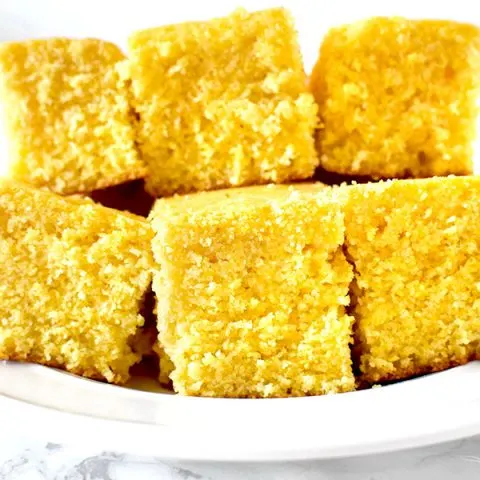
This eggless cornbread is light, fluffy, and everything a cornbread should be!
Ingredients
- 1 cup cornmeal (150 grams)
- 1 ¼ cup all-purpose flour (150 grams)
- ¼ cup or ⅔ cup white sugar (50 grams or 130 grams)
- 1 tablespoon baking powder
- ½ teaspoon salt
- 1 ¼ cup water (295 milliliters)
- ⅓ cup oil (80 milliliters)
Instructions
- Preheat the oven to 400°F or 205°C.
- Whisk together the cornmeal, flour, sugar, baking powder, and salt in a mixing bowl.
- Add water and oil. Mix until well incorporated.
- Using a baking spatula, pour into an 8x8 baking pan lined with parchment paper.
- Bake for 20 to 25 minutes or until a toothpick inserted into the center comes out clean. Let cool before cutting.
Recommended Products
Some of the links below are affiliate links, which means that if you choose to make a purchase, I will earn a small commission. This commission comes at no additional cost to you.
Nutrition Information:
Yield:
9Serving Size:
1Amount Per Serving: Calories: 243Total Fat: 9gSaturated Fat: 1gTrans Fat: 0gUnsaturated Fat: 8gCholesterol: 0mgSodium: 287mgCarbohydrates: 39gFiber: 1gSugar: 15gProtein: 3g
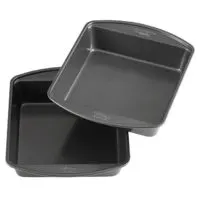
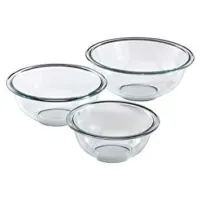
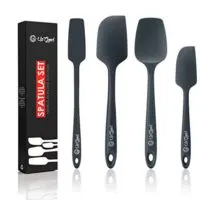
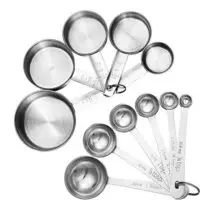
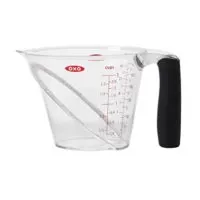
Margie
Friday 28th of February 2025
Just made it but my oven is on the fritz so I baked it in a 10" saute pan on the stovetop and it turned out perfect. Thank you for this recipe. Next I am going to try your eggless brownie, they look delicious too!
ElissaBeth
Tuesday 4th of March 2025
I'm so glad to hear it! :) ❤️
JC
Tuesday 4th of February 2025
Excellent recipe! My daughter picked cornbread to bring for her classmates but it had to be egg free due to an allergy. This recipe was simple and tasted great!
ElissaBeth
Wednesday 5th of February 2025
I'm so glad to hear it! Thank you for sharing ❤️
Just A Girl Trying to Learn
Thursday 23rd of January 2025
I made this recipe last night. I had realized that I had no eggs and started googling. I'm not a big cooker, so it was to my surprise that cornbread can be made with no eggs. The only difference is I used 1 bag of Martha Whites yellow cornbread mix and placed the dough in a muffin pan. When I say THE MOST fluffy bread I have ever eaten. Even my husband asked me what did I put in the cornbread. Also, I'm not a hugh bread eater, but I guarantee you I had a piece by itself. I will definitely be making my bread like this from now on. Thanks.
ElissaBeth
Monday 27th of January 2025
I'm so glad to hear it! Thank you for sharing ❤️
Cizon
Tuesday 25th of June 2024
2/3 cup sounds like an awful lot of sweetness in the cornbread when I usually only use 4 to 5 tablespoons when I make cornbread. I’m interested in making your recipe because of it being eggless and milkless. Would using less sugar change the structure of the batter or would it be OK to make this recipe with only 4 to 5 tablespoons of sugar? Thank you in advance for your answer.
ElissaBeth
Tuesday 25th of June 2024
It would be perfectly fine to cut down the sugar
Sandy Erwin
Tuesday 16th of January 2024
Well I didn't have any eggs but I really wanted cornbread with our goulash tonight, so I was happy to find this recipe. We were out of sugar too so I substituted Stevia. (It's the end of the month, payday is tomorrow.) I also used milk instead of water because I thought the extra milk fat would make it less dry. Fingers crossed. It's in tge oven now.
ElissaBeth
Wednesday 17th of January 2024
I hope you enjoyed it :)